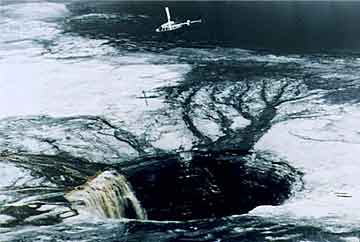| More
Absolutely Florida About the Drought The Water Cycle Water Restrictions Solutions Florida Weather Links |
What scares Stephenson, though, is the prospect of a desalinization plant - which would take the salt out of seawater and make the resulting liquid usable of humans - already approved for the St. Pete area. "A desalinization plant in a place that gets 55 inches of rain a year: That says it all right there," he said. "They've basically turned this sub-tropical environment into a desert environment." The environmental advocacy group Save Our Springs sees a similar picture.
 |
| A former gypsum stack, now a gaping hole.- photo courtesy of Save Our Springs. Background: fires are a natural result of prolonged droughts. Photo courtesy of the South Florida Water Mangement District. |
"Unchecked growth means unchecked water use," said the group's vice president, Brad Willis, and Florida is "development stressed, big time." The results are obvious in the state's many springs. They used to run clear, but are now brown or green and full of algae, he said. Some are down from a torrent to a trickle. Others are sucked dry by companies that bottle and sell the water out of state - and sometimes out of the country.
SOS has a particular beef with Perrier, which bottles water from Crystal Spring under the Zephyrhills label. The spring also is a source of the Hillsborough River, from which Tampa gets its drinking water. The group says Perrier's pumping is a threat to the environment - and backs up that claim with some very unappetizing photos on its website (http://www.saveourspringsinc.org)
Water districts are still OK'ing permits for golf courses and uncapped, unused artesian wells spew out millions of gallons of water, Willis said. Yet water managers impose restrictions on residents. "Who are we saving water for?" he demands. Even the St. Johns water management district admits, in a piece about conservation on its website, that "fickle weather cycles with abundant rain followed by drought cannot replace the millions of gallons of water that are used daily by a growing population."
But
scientists and water managers don't see a particularly dark cloud overhead.
A decline in the level of the aquifer - which supplies drinking water
- isn't due to water coming out, but rather lack of water going in.
In other words, low supply. "Man-made stresses are small compared
to natural stresses," said Knowles of USGS, citing his study that
some 80 percent of rainfall is lost through evaporation.
As for springs, flow might be affected by pumping in localized spots,
he added, but overall, they rise and fall according to pressure in the
system as a whole. And if you're chafing about not being allowed to
water your lawn, consider that those apparently wasteful golf courses
aren't getting everything they want, either, said Cole, of St. Johns
WMD. Not only are they not getting a permit for all the gallons they
want, they're not getting high-quality potable stuff, either. Instead,
they get lower quality and recycled water - stuff you can't drink. "There's
adequate water for today and for future demand," said Cole, "as
long as the situation is properly managed."
MORE